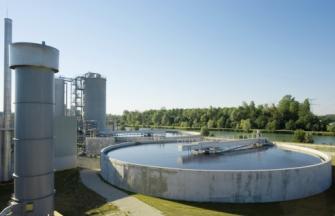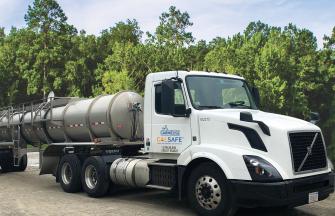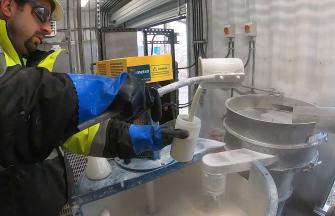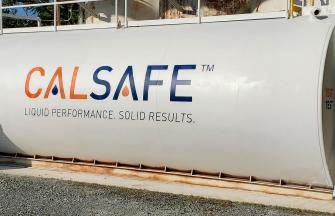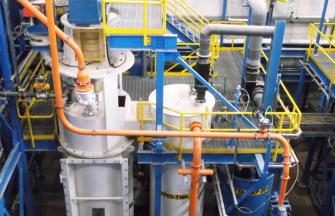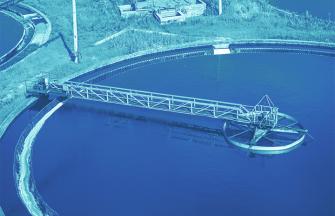
What is Lime?
Both quicklime and hydrated lime are dry bulk products derived from limestone (calcium carbonate, CaCO3). The calcium oxide material known as Quicklime (sometimes called lime) is produced by heating limestone in a kiln to drive off carbon dioxide (calcination). Adding water to quicklime initially produces dry hydrated lime. This fine white powder is the basic ingredient in lime slurry.
So, What is Lime Slurry
By adding water to quicklime you will produce a suspension of calcium hydroxide particles through an exothermic reaction known as lime slaking (more below). This suspension is what we refer to as lime slurry, also known as milk of lime or limewater. Lime slurry is the form of lime most often added to water and wastewater treatment processes.
For more on the different forms of lime like lime slurry, check out our article Quicklime, Hydrate or CALSAFE® lime slurry?
How is lime slurry used in water treatment?
Lime slurry serves as an economical source of alkalinity for pH adjustment. Lime slurry acts to increase the pH of the raw water to which the lime slurry is added, this pH adjustment method is used for many different purposes. Typical lime slurry applications are things like neutralizing acidic waters. In wastewater treatment, lime slurry helps to make it safe either for releasing back into natural bodies of water or for re-use in industrial processes. Meanwhile, neutralizing drinking water with lime slurry helps prevent corrosion and leaching of water pipes.
But this isn’t the only benefit gained by using lime slurry in water treatment processes. Lime slurry also serves a number of other functions; the most notable of which are mentioned below:
Aids the removal of contaminants
Lime slurry usage facilitates the removal of unwanted elements like heavy metal precipitation in water treatment processes in two distinct ways:
- Lime slurry acts as an aid to coagulants, such as alum or iron salts, neutralizing the negative charges held by suspended contaminants, such as natural organic materials, and facilitating their coagulation into larger particles (flocs). These particles can then be removed by filtration or sedimentation.
- As a cost-effective alkali solution, lime slurry facilitates the removal of various dissolved metals, such as iron, manganese, lead, cadmium and others, by pH adjustment. The pH is raised to the point where these metals precipitate out.
Helps disinfection and odor control in biosolids
Raising the pH of biosolids derived from municipal wastewater treatment to levels >10.5 for a period of 24 hours to 72 hours has a disinfecting function because bacteria, such as E-coli, are unable to survive in high alkalinity. This raising of the pH helps with odor control.
Lime-stabilized biosolids are also less likely to release offensive odors, while having beneficial uses for soil amendment and land reclamation. This odor control isn’t exactly necessary, but is extremely helpful to those working with the lime-stabilized biosolids.
Softens hard water
Look inside a kettle in hard water areas and the effects of water hardness are clearly visible in the scale that builds up there. But what exactly is water hardness?
The simple answer is that hardness is the concentration of dissolved calcium and magnesium compounds in water; the higher the chemical to water ratio, the higher the concentration, and therefore the harder the water. The aim of water softening is therefore to reduce those compounds. The chemical reactions to do so are complex and beyond the scope of this short article (but can be found in more detail here).
Ultimately, and as with the removal of dissolved metals, raising the pH of raw water allows the precipitation of calcium and magnesium as solid particles of calcium carbonate and magnesium hydroxide, which can then be removed.
What’s the best lime slurry system for me?
As mentioned above, lime/calcium hydroxide slurry is the primary vehicle for adding lime to water treatment processes. But when it comes to sourcing it, there are a number of options. You can make it onsite, using either quicklime or hydrated lime, or you can buy a ready-mixed lime/calcium hydroxide slurry, such as CALSAFE from Carmeuse.
Generally speaking, quicklime is the cheapest form of lime. However, it requires the highest investment in onsite equipment to produce lime/calcium hydroxide slurry, since a lime slaker is required to safely control the exothermic slaking reaction. Hydrated lime is more expensive on a per-ton basis, but CAPEX requirements are lower, since there is no need for a slaker. Ready-mixed slurries are the most expensive on a per-ton basis, but are easiest to use and need the least investment in onsite equipment.
To discuss what system will work best for your specific application, contact our experienced team today.
Whatever your choice of lime slurry system, Carmeuse is able to supply your needs - from CALSAFE ready-mixed lime slurry, to dry hydrated lime or quicklime. Meanwhile, Carmeuse Systems, is the expert when it comes to lime handling, providing high-quality lime slakers, mix tanks and other materials handling equipment.
CALSAFE ready-mixed lime slurry
CALSAFE is a ready-mixed hydrated lime slurry from Carmeuse. It is produced at four locations in North America to slightly differing specifications.
In the US, our facilities in Baltimore, MD, and East Chicago, IN, produce a slurry that is a 40% suspension of calcium hydroxide by weight solids, while our Bellingham, MA, facility produces slurry that is closer to a 30% suspension of calcium hydroxide by weight solids.
In Canada, our Blind River Operation in Ontario produces slurry that is a 25% suspension of calcium hydroxide by weight solids.
What equipment do I need?
When you have decided what type of lime slurry system is best for your application, it is time to turn to the equipment you will need to handle and store the slurry. If opting for quicklime or hydrated lime, you will also need the equipment to turn those dry products into slurry in the first place.
Whatever your slurry system, be it slaked or mixed on site or delivered ready-mixed to your door, all slurry systems require a mix tank in which to store the slurry and keep the calcium hydroxide particles in suspension.
When using ready-mixed slurry, this mix tank is basically all you will need.
If using hydrated lime to produce slurry on site, equipment requirements extend to dry bulk storage and feed systems, as well as a control system to regulate the flow of dry lime and water into the mix tank.
Slaking quicklime on site requires a similar set-up, but with the addition of a lime slaker. If you are taking this route, we recommend reading this comprehensive introduction to lime slaking from Carmeuse Systems, which includes a discussion of the main factors that impact the slaking process and the four types of slaker.
Carmeuse Systems experienced experts are also available to discuss your particular lime slurry application and slurry handling needs. They will support you in selecting the best slurry system for your operation.
Is lime slurry hazardous?
Lime is an irritant, and health and safety precautions should be taken to avoid direct contact with eyes and other mucus membranes, e.g., wearing safety glasses with eye shields. Where there is risk of direct contact with the skin, appropriate protective clothing and gloves should also be worn.
For more detail on what you should consider when handling lime slurry, take a read through our good practice guide.
Slurry produced on site will initially be quite hot (at about 180∘F), raising the risk of thermal burns unless appropriate safety measures are in place.
In addition, while lime slurry itself is not flammable, it does react violently with acids, releasing sufficient heat to ignite combustible materials. Slurry storage areas should therefore be kept clear of flammable items.
In terms of environmental applications, lime slurry is relatively benign (unlike other basic materials, such as caustic soda) and is not considered a hazardous chemical when it comes to shipping. Dry chemical handling such as handling lime should still be done with gloves. Spills should be cleaned up quickly with quantities of water. Unless there is a large-scale release into a natural body of water, lime slurry does not pose a major risk to environmental applications.
For general cleaning, pressurized water is sufficient for most applications. Weak acids, such as vinegar and citric acids, also do a good job of cleaning slurry scale build-up in equipment.
Going deeper on lime slurry for water treatment
And with that mention of citric acid, we are brought back to that little green citrus fruit (although we wouldn’t recommend using them to clean your slurry system), and the end of this brief exploration of lime slurry and its use in water and wastewater treatment.
To continue exploring the topic, you can read about our lime-based products and services for the Municipal Water & Biosolids and Drinking Water industries, or discover Carmeuse Systems and its expertise in lime slaking systems.
Alternatively, you can connect with us directly to discuss your specific application. With our extensive team of experts at the Carmeuse Innovation Center in Pittsburgh and at Carmeuse Systems, we are always happy to discuss any specific needs or questions, to help you get the most out of your lime.


